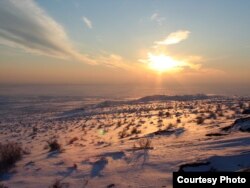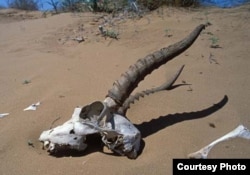Western nongovernmental organizations and their Central Asian partners have joined efforts to save the unique grassland of the Ustyurt Plateau, a temperate desert lying between the Caspian and the Aral seas.
The plateau, a vast area of about 200,000 square kilometers shared between Uzbekistan, Kazakhstan, and Turkmenistan, is a globally important steppe landscape.
Paul Hotham is the Eurasia regional director for Fauna & Flora International (FFI), a British-based conservation group involved in the five-year project. He says that the Ustyurt Landscape Conservation Project aims to promote the long-term sustainable management of both the Uzbek and Kazakh parts of the plateau.
"We want to do this by focusing at issues that are at the landscape-scale, and we are going to use the saiga antelope as a...species, also as a flagship -- and emblem if you like -- for the landscape," Hotham says. "The idea is to improve conservation, but to do that in a way which also balances needs for local development, for local people. So we are going to be carrying out some essential baseline -- social, ecological, and species -- survey work."
Symbolism Of The Saiga
The landscape is a mosaic of eroded hills, shallow basins, and extensive escarpments, with no permanent streams or open fresh-water sources.
With a high degree of endemism -- species that can only be found locally -- the plateau is home to vegetation types well-adapted to a harsh environment, including gypsum- and salt-tolerant plants.
Breeding bird populations include the houbara bustard (Chlamydotis undulata), saker falcon (Falco cherrug), lesser kestrel (Falco naumanni), eastern imperial eagle (Aquila heliaca), and black vulture (Aegypius monachus).
Still found are ungulates like the goitered gazelle (Gazella subgutturosa subgutturosa) and the Ustyurt urial (Ovis vigneri arcal), as well as mammal predators such as the marbled polecat (Vormela peregusna).
But the area's most famous resident is undoubtedly the saiga antelope (Saiga tatarica tatarica). With its bulbous, tubular nose and bulging eyes, the nomadic antelope is certainly one of the world's strangest-looking mammals. It's also on a list of critically endangered species by the International Union for the Conservation of Nature.
The collapse of economies across the antelope's range has been a major factor driving an unsustainable increase in poaching for its meat and horn, an ingredient in traditional Chinese medicine.
Hotham says the saiga population has shrunk from more than 1 million in the 1990s to around 50,000 today, in five populations located in Kazakhstan, Russia, Turkmenistan, and Uzbekistan.
And the Ustyurt population is particularly vulnerable, with less than 10,000 on the plateau, which Hotham says is the "only population of the five that is still in decline. All the other areas have received some form of enhanced protection and attention from conservation efforts. The population on the Ustyurt used to run into the hundreds of thousands."
Conservation Through Local Development
A range of human-related impacts are denuding and fragmenting the landscape and its habitats, affecting species' diversity, number, and migration. Meanwhile, social and economic difficulties have caused a sharp decline in funding for conservation efforts in a landscape susceptible to degradation and desertification.
The Uzbek part of the Ustyurt Plateau faces high unemployment and water-supply shortages. It is located in the Karakalpakstan region, which has been the worst affected by the desiccation of the Aral Sea.
FFI has been involved in conservation there for more than five years, supporting and engaging communities in saiga antelope conservation. Groups of Saiga Friends have been formed to act as advocates for conservation in the communities and saiga monitors engaged to support scientific research and monitoring.
The new project will build on this work, addressing a wide range of issues related to poverty, poaching, illegal wildlife trade, overgrazing, lack of conservation capacity, funding and policy, and the effects of an increasingly active oil and gas industry. Among other activities, Hotham says it will engage local people to try to reduce their impact on wildlife and improve their livelihoods at the same time.
"Often, within local communities, [there] are entrepreneurs or people with ideas about how they can improve the lot for their community or for their own family. But they don't have funding, for example, to be able to put these ideas into action," Hotham says.
"So following on from discussions and the identification of possible opportunities, we are then going to provide some small grants -- otherwise known as microfinance -- to provide the finances and some of the training and technical support that people would need to keep some of these projects going."
The project will have an overall budget of about $1.5 million, mainly provided by the U.S. Agency for International Development. And it will be delivered by a consortium of NGOs, including FFI, BirdLife International, Pact, and ACDI/VOCA.
The consortium will be working in partnership with local partners and stakeholders, including state conservation and enforcement agencies, national scientists, as well as local communities.
In 1991, Uzbek authorities designated a protected area in Ustyurt to safeguard saiga lambing grounds. But with no funding or staff, this never got further than being a "paper park." Hotham says the new project will try to support the redesignation of the Saigachy reserve -- a process that has been approved by the local government:
"We're looking at the borders of the reserve; we're looking at the needs of managing that area. We are looking at the type of designation that should be put in place there, the number of staffing, the skills of those staff," he says. "And we're going through a process which is administrative, bureaucratic -- jumping through certain legal hoops -- and political, building there local and regional support for the protected area."
In Kazakhstan, the Ustyurt Nature Reserve protects 223,000 hectares of the plateau. Turkmenistan's 282,000-hectare Kaplankyr Nature Reserve covers the Ustyurt Plateau's southern spur.
The plateau, a vast area of about 200,000 square kilometers shared between Uzbekistan, Kazakhstan, and Turkmenistan, is a globally important steppe landscape.
Paul Hotham is the Eurasia regional director for Fauna & Flora International (FFI), a British-based conservation group involved in the five-year project. He says that the Ustyurt Landscape Conservation Project aims to promote the long-term sustainable management of both the Uzbek and Kazakh parts of the plateau.
"We want to do this by focusing at issues that are at the landscape-scale, and we are going to use the saiga antelope as a...species, also as a flagship -- and emblem if you like -- for the landscape," Hotham says. "The idea is to improve conservation, but to do that in a way which also balances needs for local development, for local people. So we are going to be carrying out some essential baseline -- social, ecological, and species -- survey work."
Symbolism Of The Saiga
The landscape is a mosaic of eroded hills, shallow basins, and extensive escarpments, with no permanent streams or open fresh-water sources.
With a high degree of endemism -- species that can only be found locally -- the plateau is home to vegetation types well-adapted to a harsh environment, including gypsum- and salt-tolerant plants.
Breeding bird populations include the houbara bustard (Chlamydotis undulata), saker falcon (Falco cherrug), lesser kestrel (Falco naumanni), eastern imperial eagle (Aquila heliaca), and black vulture (Aegypius monachus).
Still found are ungulates like the goitered gazelle (Gazella subgutturosa subgutturosa) and the Ustyurt urial (Ovis vigneri arcal), as well as mammal predators such as the marbled polecat (Vormela peregusna).
But the area's most famous resident is undoubtedly the saiga antelope (Saiga tatarica tatarica). With its bulbous, tubular nose and bulging eyes, the nomadic antelope is certainly one of the world's strangest-looking mammals. It's also on a list of critically endangered species by the International Union for the Conservation of Nature.
The collapse of economies across the antelope's range has been a major factor driving an unsustainable increase in poaching for its meat and horn, an ingredient in traditional Chinese medicine.
Hotham says the saiga population has shrunk from more than 1 million in the 1990s to around 50,000 today, in five populations located in Kazakhstan, Russia, Turkmenistan, and Uzbekistan.
And the Ustyurt population is particularly vulnerable, with less than 10,000 on the plateau, which Hotham says is the "only population of the five that is still in decline. All the other areas have received some form of enhanced protection and attention from conservation efforts. The population on the Ustyurt used to run into the hundreds of thousands."
Conservation Through Local Development
A range of human-related impacts are denuding and fragmenting the landscape and its habitats, affecting species' diversity, number, and migration. Meanwhile, social and economic difficulties have caused a sharp decline in funding for conservation efforts in a landscape susceptible to degradation and desertification.
The Uzbek part of the Ustyurt Plateau faces high unemployment and water-supply shortages. It is located in the Karakalpakstan region, which has been the worst affected by the desiccation of the Aral Sea.
FFI has been involved in conservation there for more than five years, supporting and engaging communities in saiga antelope conservation. Groups of Saiga Friends have been formed to act as advocates for conservation in the communities and saiga monitors engaged to support scientific research and monitoring.
The new project will build on this work, addressing a wide range of issues related to poverty, poaching, illegal wildlife trade, overgrazing, lack of conservation capacity, funding and policy, and the effects of an increasingly active oil and gas industry. Among other activities, Hotham says it will engage local people to try to reduce their impact on wildlife and improve their livelihoods at the same time.
"Often, within local communities, [there] are entrepreneurs or people with ideas about how they can improve the lot for their community or for their own family. But they don't have funding, for example, to be able to put these ideas into action," Hotham says.
"So following on from discussions and the identification of possible opportunities, we are then going to provide some small grants -- otherwise known as microfinance -- to provide the finances and some of the training and technical support that people would need to keep some of these projects going."
The project will have an overall budget of about $1.5 million, mainly provided by the U.S. Agency for International Development. And it will be delivered by a consortium of NGOs, including FFI, BirdLife International, Pact, and ACDI/VOCA.
The consortium will be working in partnership with local partners and stakeholders, including state conservation and enforcement agencies, national scientists, as well as local communities.
In 1991, Uzbek authorities designated a protected area in Ustyurt to safeguard saiga lambing grounds. But with no funding or staff, this never got further than being a "paper park." Hotham says the new project will try to support the redesignation of the Saigachy reserve -- a process that has been approved by the local government:
"We're looking at the borders of the reserve; we're looking at the needs of managing that area. We are looking at the type of designation that should be put in place there, the number of staffing, the skills of those staff," he says. "And we're going through a process which is administrative, bureaucratic -- jumping through certain legal hoops -- and political, building there local and regional support for the protected area."
In Kazakhstan, the Ustyurt Nature Reserve protects 223,000 hectares of the plateau. Turkmenistan's 282,000-hectare Kaplankyr Nature Reserve covers the Ustyurt Plateau's southern spur.

















